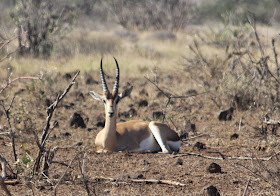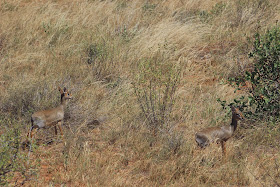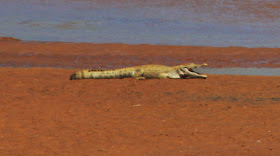 |
| Vervet monkey outside our lodge. (Photo by E. Tooke) |
Ever since we got home from Africa, we have been asked a lot of questions about our trip, and a few keep popping up.
Question: Were your game drives crowded? Were there lots of people gawking at animals and causing traffic jams like there are in Yellowstone?
Answer: No, they weren't crowded at all. For example, seven safari lodges surround Buffalo Springs National Reserve, which is a relatively small reserve. Anyone can bring a private car into the reserve, but almost everyone goes with a tour group, which means that the tourist population is partly limited by the number of rooms available in the lodges. Of course, it is also possible to drive in with a tour, do a drive through the park, and then drive somewhere else for lodgings. We did see a few private vehicles, but they were very rare. We never felt that there were a lot of people in this (or any other) reserve/park we were in.
Question: Did your group do any hunting?
Answer: Hunting safaris ended in 1977, and Kenya joined an international animal protection group in 1978. In most cases, even the local tribes are not allowed to kill game.
Question: What time of day did you see the most animals?
Answer: We usually had two game drives in each game reserve, a morning drive and and afternoon drive. I would have expected to see many more animals in the morning than the afternoon, but it didn't seem to matter when we were looking. We saw animals all the time--although what we saw varied according to the time of day.
That should do it. Back to the safari.
Question: Were your game drives crowded? Were there lots of people gawking at animals and causing traffic jams like there are in Yellowstone?
Answer: No, they weren't crowded at all. For example, seven safari lodges surround Buffalo Springs National Reserve, which is a relatively small reserve. Anyone can bring a private car into the reserve, but almost everyone goes with a tour group, which means that the tourist population is partly limited by the number of rooms available in the lodges. Of course, it is also possible to drive in with a tour, do a drive through the park, and then drive somewhere else for lodgings. We did see a few private vehicles, but they were very rare. We never felt that there were a lot of people in this (or any other) reserve/park we were in.
Question: Did your group do any hunting?
Answer: Hunting safaris ended in 1977, and Kenya joined an international animal protection group in 1978. In most cases, even the local tribes are not allowed to kill game.
Question: What time of day did you see the most animals?
Answer: We usually had two game drives in each game reserve, a morning drive and and afternoon drive. I would have expected to see many more animals in the morning than the afternoon, but it didn't seem to matter when we were looking. We saw animals all the time--although what we saw varied according to the time of day.
That should do it. Back to the safari.
Our second game drive in Buffalo Springs National Reserve was a morning drive. After a delicious buffet breakfast at the Sarova Shaba Game Lodge, we climbed into our Land Cruisers. On our way, we passed these two delightful children with their wooden Medusa-like hairdos. It was common to see children carrying varying-sized bundles of wood. Even children in uniforms on their way to school were sometimes cheerfully carrying loads like these in their arms or on their heads.
We loved the children of Africa. The load of poverty and hunger they carry is incomprehensible to us, and yet they are full of such exuberance.
Here is what we saw on Day #2 in Buffalo Springs:
FLORA
Doum palm
Acacia with weaver bird nests
ANIMAL SIGHTINGS
(*Only sighting and **My favorites for the day)
Vervet monkey
* Golden palm weaver
Warthogs
Grevy zebra
Grant's gazelles
* Oryx
Reticulated giraffes
Gerenuk
Impala herds
Kirk's dik dik
* Common waterbuck
Baboons
Nile crocodiles
* Bateleur eagle
* Secretary bird
* Yellow-necked spur fowl
Hadada ibis
* Eastern pale chanting goshawk
* Red-billed hornbill
Superb starlings
* **Verreaux eagle-owl (with a genet in his claws)
**Elephants (75 or more of them, our best sighting anywhere
and so awesome that they merit their own post after this one)
Before I get to the animals, I want to mention an especially interesting tree, the doum palm, which can grow over 50 feet tall and is the only palm in the world with branches. About halfway up the tree, the stalk divides in two, and then each of the branches continues to subdivide, always into two branches, looking like a genealogy pedigree chart reaching upwards rather than to the right. Tufts of palm fronds erupt at the ends of each branch. With it's high, bushy foliage and bare trunk, it looks like the product of a mixed marriage between a palm and an acacia:
 |
| A great name for this palm would be the Pedigree Tree |
Doum palms grow in arid African regions, usually near some ground water or by streams, providing shade where other trees won't grow.

And while I'm on trees, how about these weaver bird nests, the most elaborate nests in the world, according to Wikipedia.They are built by the male, often as a way to attract a mate. (Women of all species are real suckers for a fancy house.) Different weaver bird species build different styles of nests:
. . . and it's not uncommon to see dozens in a tree, floating like prickly bubbles from the even pricklier branches:

We caught a glimpse of some warthogs, an animal we would get a better look at later:
We got our last look at an endangered Grevy's zebra with its distinctive white belly and thin stripes:
Grant's gazelles are gregarious animals that travel in herds, a group of five to fifteen females attended by a single territorial male. And so what happens to all of the other males? Just like teenage boys, they hang out together and cause trouble. A group of these unattached male gazelles is called a bachelor herd, and members are easily distinguished by their horns, which are longer and heavier than the females' horns:
 |
| A bachelor herd with Mount Kenya looming in the background |
 |
| This one must be a teenager--too lazy to get moving in the morning. |
It's hard work carrying those horns around. Gotta take a rest now and then:
The sultan doesn't show up in this photo of an impala harem:
. . . but he was nearby, keeping on eye on them:

In contrast, waterbucks are 47-54 inches at the shoulder and weigh 350-575 pounds. Males generally have horns, so these must be two females having a morning chat:
This Nile crocodile looked so sweet sunning himself on a mudbank:
. . . but then I saw his buddy open his big mouth to cool himself down. That's an impressive set of jaws, certainly big enough to get a good grip on my leg. I don't think I care to socialize, thank you.
The Bateleur eagle breeds during December through March and is supposed to have well-concealed nests in trees, but this sloppy mess was pretty easy to spot. The mother lays only one egg and has to sit on it for 42-43 days, and then care for the fledging for up to four months. Bateleurs pair for life.
 |
| (Photo by M. Lewin) |
Iridescent peacock blue shines out from under the dull black topcoat of the hadada ibis. Its name comes from its call: "Ha-ha-ha-dee-dah!"
 |
| Photo by Bob |
The Eastern pale chanting goshawk wins the award for having the most intriguing name. According to Birds of Kenya and Northern Tanzania, during the nesting season "its calls are a melodious piping whee-pee-pee-pee, and a long high-pitched kleee-yeu," which is the source of its name:
We had another sighting of the red-billed hornbill, a goofy-looking bird whose head and neck appear to be about 50% of its total body size:
One of the most unique and dramatic sightings we had on the entire trip was of a Verreaux's eagle-owl. After we heard from another safari vehicle that there was a leopard in a tree, our driver rushed us to the spot, and when we arrived, we could see a long, hairy tail dangling from the crook of the tree, but the body above the tail wasn't quite right. We couldn't tell what we were seeing until we zoomed in with our cameras and binoculars for a better look. We saw an unmistakable face and realized it was an owl sitting on top of a cat body. It must have killed the cat (which Bob later determined to be a genet) during the previous night, and it had been sitting on it all morning. The largest African owl and third heaviest owl in the world, this is a powerful bird. Its wing span can be up to 55 inches, and Wikipedia notes that it is a "seldom-encountered species." The eagle-owl looks like a heavily made-up woman, complete with painted on eyebrows, eyeliner, lipliner above the beak, and a salon-styled poufy hairdo.
The other vehicle in our group later saw the eagle-owl fly off with the cat in its talons:
 |
| Photo by E. Tooke |
Now that is something you just don't see in California.
NEXT: AN ELEPHANT PARADE

.JPG)






















Very fun to see the game drive and various animals through your eyes. Part of the reason Buffalo Springs may be my favorite preserve was the interesting bird life: secretarybird, yellow-necked spurfowl, bateleur eagle, pale chanting goshawk, Verreaux's eagle owl, red and yellow-billed hornbills, in addition to the gerenuk, oryx, reticulated giraffe, common waterbuck that we only saw here.
ReplyDeleteThe list of animals and birds is astonishing. It's fun to read about the variety of birds and animals in this part of the world.
ReplyDeleteAmazing Eagle Owl piece and I love the Secretary Bird. ... Judy, you definately picked the right major ... this is absolutely staggering!
ReplyDeleteThe list is getting longer, but your descriptions are still spot on and captivating. Good think Bob brought you along to keep everything all described and ordered! (Kidding--I know he wouldn't go anywhere without you.) I'm wondering if the best safaris are organized around known "animal-sighting" stops, rather than just a road through the wilderness? Any ideas?
ReplyDeleteLetterpress, with a few exceptions, such as hippos, I think it's impossible to predict with any consistency where the animals will be in the reserve. Certainly that's true for the hunters like lions and cheetahs. It really helps that the drivers can communicate on their radios. When one has an especially interesting find, he can share his location with other drivers, although some of the reserves are so huge (Serengeti, for example) that it doesn't always work.
ReplyDelete